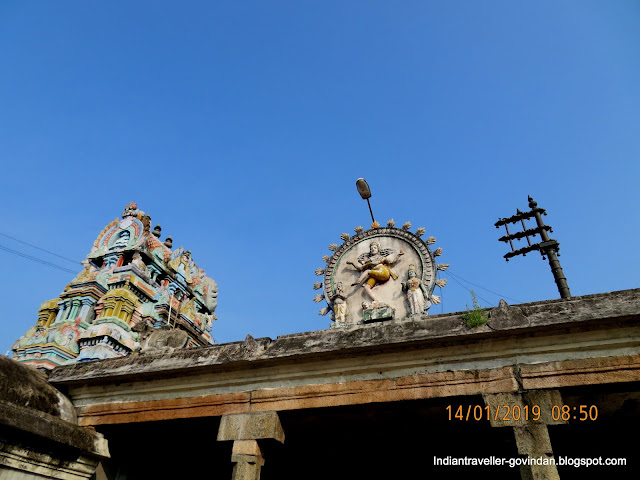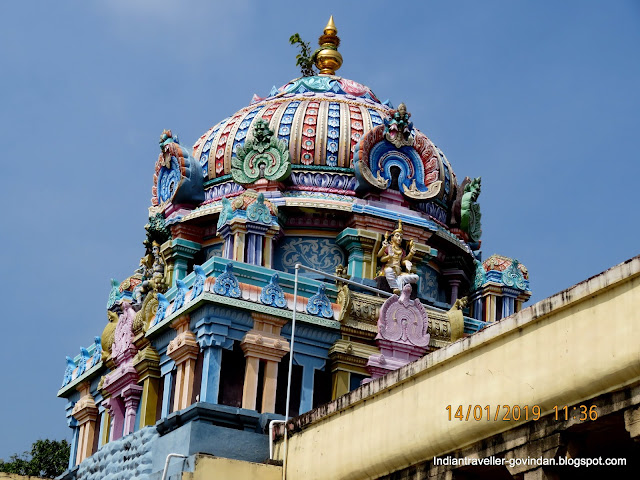NAVAGRAHA TEMPLES - KUMBAKONAM- THANJAVUR- KARAIKAL
I had been planning to visit Navagraha temples and other major temples in Kumbakonam and Thanjavur for a long time. After discussing with my wife who loves temple visits we decided to visit these temples during Pongal/Sankranthi festival this year. Accordingly we booked our tickets to Kumbakonam by Myladuthurai express 16232 leaving Bangalore at 7 PM and reaching Kumbakonam at 5.45 AM. Timing-wise, this is convenient train. The only drawback is that the train does not have a pantry and it is better to carry food and water.
We had booked our stay at Sara Regency - a modest 3 star hotel and also made arrangements to hire a taxi for visiting the temples. We discussed with the driver the best way to cover all Navagraha temples and a few other important temples and finalized our plans. The hotel was kind enough to provide us a map giving locations and distances of temples.
HOW WE PLANNED THE VISIT
Day-1
Morning- Thirunageswaram (Rahu Temple) - Uppiliappan Temple - Alangudi (Guru Temple)
Patteswaram Temple - Thiruvalanchuzhi - Swamimalai.
Afternoon- Airawateswar Temple - Aadhi Kumbeswar Temple - Sarangapani Temple - Mahamaham Tank - Chakrapani Temple.
Day-2 Suryanallar (Sun Temple) - Kanchanur (Sukran Temple) - Thirumanancheri - Mayiladuthurai Vaitheeswaran Koil (Sevvai) - Thiruverkadu (Budhan Temple) - Keezhperumpallam (Ketu Temple) - Thirunallar (Saneeswara Temple)
Day-3 Gangaikonda Cholapuram - Thingaloor (Chandran Temple) - Thanjavur.
Day-4 Brihadeeswara Temple - Punnainallur Mariamman - Sivagangai gardens - Swartz Church - Thanjavur Palace.
This blog relates only to Navagraha Temples. The other temples are covered separately.
NAVAGRAHA TEMPLES LOCATION MAP
RAHU TEMPLE
The first temple we visited was Thirunageswaram (Rahu temple) which was about 10 Kms from our hotel. Sri
Naganathaswamy Temple, Thirunageswaram has exclusive shrines for
Naganatha Swamy (Shiva), Pirayani Amman (Parvathi), Giri-Gujambika (Parvathi)
and Rahu with his divine spouses. Goddess Girigujambika has a separate shrine
in the north side inside the temple campus as it is believed that the goddess
is in mode of deep penance. This temple is believed to be built in 10 th Century by Aditya Chola. The temple tank is named Surya Pushkarini.
A
unique feature of Sri Naganathaswamy Temple is that Rahu Bhagavan is seen with a human face. Usually in other places, Rahu Bhagavan is seen with a serpent face.
Here Rahu Bhagavan is present with his two consorts Nagavalli and Nagakanni.
Timings- 6 am -12.45 pm and 4 pm -8.30 pm
GURU TEMPLE
The next Navagraha temple we visited was Guru temple at Alangudi about 17 Kms.
Aapatsahayeswarar Temple, Alangudi is one of the Navagraha temples dedicated to Lord Shiva located in the village of
Alangudi in the of Tiruvarur district. Alangudi is the “Guru Stalam” dedicated to the planet Jupiter.
The presiding deity here is Aapathsahayeswarar and his
consort is Elavarkuzhali Ammai or Umayammai. The other deities are, Lord Ganesha/Vinayagar known here as “Sri
Kalangamar Katha Vinayagar”, Lord Murugan with his consorts; and
Goddess Lakshmi. The temple has a 5-tier rajagopuram; one facing main deity and the other gopuram facing North side.
Timings 6 am -12 pm
and 4 pm -8 pm
SUKRAN TEMPLE
The next Navagraha temple we visited was Kanjanoor. Agneeswarar Temple at Kanjanoor is dedicated to Lord Sukran Venus planet. Lord Shiva and
Parvati in Kanjanur are worshipped as Agneeswarar and Karpagavalli Amman. The
main deity, Agneeswarar in the form of lingam depicts Lord Sukra. The Idol of Natarajar is very beautiful. In addition we visited shrines of Subramanya swamy on peacock,Mahalakshmi, Anjaneyar, Navagrahas and Bhairavar inside temple corridor.
Timings 7 am -12 pm and 4 pm -8 pm
SEVVAI TEMPLE
Vaitheeswaran temple was the next in our Navagraha temple visit. Vaitheeswaran
Koil dedicated to the Lord Shiva. Shiva
is worshipped as Vaitheeswaran or the “God of healing” and it is believed that
prayers to Vaitheeswaran can cure many diseases. This
is a very big temple.
The Vaitheeswaran Koil has a 5-tier Rajagopuram. The central
shrine is that of Vaitheeswaran present as lingam in the innermost place. The other images of deities in the sanctum are
of Natarajar, Somaskanda, Angaraka and stone sculptures of Durga,
Dakshinamoorthy, Surya (Sun god), Jatayu, Vedas, Sampati. The shrine of
Thaiyalnayaki who stands with the medicinal oil to cure the diseases of the
devotees is present in the second precinct facing south. It is believed by devotees that they pour salt, pepper and jaggery in front of this Goddess, they will be cured of all ailments. They sell packets of these items for the convenience of pilgrims.
The large precinct
also has a small shrine to Dhanvantari and shrine of Angaraka in stone
sculpture. The southern gateway from this precinct leads to the temple tank and
directly faces the Thaiyalnayaki shrine. The Sthala Vriksha or temple tree is
Neem tree, which possesses medicinal properties. It is
located in the eastern gateway of the temple. The eastern gateway also has the
model temple that is a replica of the main shrines.
There is a fine metal image of Gangavisarjanar inside the temple.
The Vaitheeswaran Koil is guarded by Bhairava on the East,
Veerabhadran on the west, Karpaga Vinayagar on the South and Mother Kali on the
north. The sanctum faces west.
The Navagrahas unlike in other temples, are in a row. There
is a separate idol for Chevvai.
Vaitheeswaran Koil has several mandapams and 4 rajagopurams and a significant feature in the temple construction is that the western tower allows the rays of the sun to fall on the Shivalingam for a few days every year.
Timings 6 am -1 pm and 4 pm -9 pm
BUDHAN TEMPLE
After visiting Vaitheeswaran temple we went to Thiruvenkadu where Budha (Planet Mercury) temple is located. We entered the temple through a seven-tiered Gopuram with 9 kalashas.
Swetharanyeswarar temple is the abode of Bhudhan at Thiruvenkadu. The main deity is Shiva –
Swetharanyeswarar and the goddess is Brahma Vidya ambal. Budhan is said to
bestow wisdom and intellect.
The structure of this east-facing Swetharanyeswarar Temple itself consists of two huge towers on the western and eastern sides.
Thiruvenkadu Temple is surrounded by pancha prakarams. Here the Lord is
consecrated in his forms as Aghoramurthi (manifestation of His wild and angry
form) and Nataraja (a manifestation of Shiva, the celestial Dancer).The
Nataraja image holds seven instruments and weapons, namely, Vetalam, Khadgam,
Udukku, Mani, Kedayam, Kapalam and Trisulam.
The temple tank named Chandra Theertham is said to wash away all problems once someone takes a dip. Pilgrims perform parihara if they have Budha doshas.
This temple is believed to be originally built by Cholas but the present architecture is of Vijayanagara style of 16th Century.
Timings 6 am -12 pm and 4 pm -9 pm

KETHU TEMPLE
Keezhperumpallam Ketu temple was our next in the temple list. Naganathaswamy Temple
is located in Keezhaperumpallam. The
main idol in the temple is that of “Naganatha swamy”(Lord Shiva) with his consort Soundaryanaki and the
presiding deity is Ketu - a shadow planet. Here Ketu is enshrined with head of a snake
and body of a demon. Naganathaswamy temple was constructed by Chola Kings.
In this Kethu temple, Lord Kethu faces west in the north prakaram.
Lord Kethu
appears with the body in divine form, his head as a five-headed snake and the folded hands worshipping Lord Shiva.
This temple has two tier Rajagopuram with two precincts.
Timings -6 am –1 pm and 4 pm -8.30 pm
SANI TEMPLE
Next Navagraha temple we went to was at Tirunallar dedicated to Sri Sani Bhagawan located at Karaikal which was about 60 Km from Keezhperumpallam.
Tirunallar Saniswaran Temple or Dharbaranyeswarar Temple is
dedicated to Lord Shani (Saturn) in Karaikal district of Pondicherry. The
presiding deity is Lord Shiva, Dharbaranyeswar and the place Thirunallar was
historically called Dharbaranyam
This is the only temple where Lord Shaneeshwara lost all his
power to Lord Shiva (Dharbaranyeshwarar) which saved his devotee Nalan from
Saturn’s curses. It is believed that by bathing in Nalatheertham here, one
washes off all kinds of misfortunes and afflictions caused by one’s past karmas.
Tirunallar Saniswaran Temple is of 12th century architecture.
The shrine of Shaneeshwara is to the north of the tower at
the entrance. The Linga which King Nalan worshipped called Nalesar Lingam also
is to be seen. Golden Ganapathy is unique to this temple. There are also
shirnes for Lord Murugan, Adhiseshan, Nalanarayanar, Mahalakshmi and Bhariavar
Timings -6 am -12.30 pm and 4 pm-9 pm
SURYAN TEMPLE
Sooryanallar is about 10 Km from Kumbakonam and the temple here is dedicated to Lord Surya (Sun God).
It is located in the village of Suryanarkoil in the Thanjavur district.
It is a very famous Surya Sthalam and is one of the Navagraha
temples.
The Suryanar Kovil faces west. The presiding deity here is
Suryanarayana in a chariot like vimaanam, representing the sun’s chariot. There
are also shrines to Kasi Viswanathar, Visalakshi and Brihaspati (Guru) in the
sanctum. Shrines to the other celestial bodies are located outside of the
sanctum.
In the sanctum itself, Suryan stands with Usha Devi at his
left and Chaya Devi at his right. Guru faces Suryan. The sanctum and the
ardhamandapam are built of stone, while the rest of the shrines are brick
structures. The KolTheerthaVinayakar shrine is considered to be of importance
here. The tower of the temple is 15.5 meters in height and consists of three
tiers. At the top of the tower are five domes. All the other seven grahams face Surya
Bhagawan in this temple and have separate shrines inside the temple. The Lord’s vehicle is the
horse, which goes by the name ‘Saptha', meaning seven in Sanskrit. The
one-wheeled chariot is drawn by seven horses.
The entrance of the temple is adorned with a disc (Universe) with Surya in the chariot at the center surrounded by other eight grahas in respective directions representing eight directions.
Timings 6 am-12.30 pm and 4 pm -8 pm
CHANDRAN TEMPLE
Our last visit was to Thingalur which is about 30 km from Kumbakonam on way to Thanjavur.
The Kailasanathar Temple is one of the nine Navagrahasthalas
located at Thingaloor. The presiding deity is Chandran - planet moon. However, the main
idol in the temple is that of “Kailasanathar” or Shiva. The main deities
worshipped here are Kailasanathar (Lord Shiva) and Goddess
Periyanakiamman (Goddess Parvati). We were told about a unique feature of Thingaloor Temple is that during the months
of September – October and March –
April, the rays of the moon fall on the Shiva Lingam on full moon days. The temple is believed to be built by Cholas in 12th century.
Timings 7 am-1 pm and 4 pm -8 pm
A separate blog is being written on other important temples like Patteswaram Temple, Uppiliappan temple,Airawateswar temple,Sarangapani temple, and Chakrapani temple near Kumbakonam.
For return journey we used the same train Myladuthari express 16231 from Thanjavur leaving Thanjavur at 7.45 pm to reach Bangalore around 5.30 am.
































































